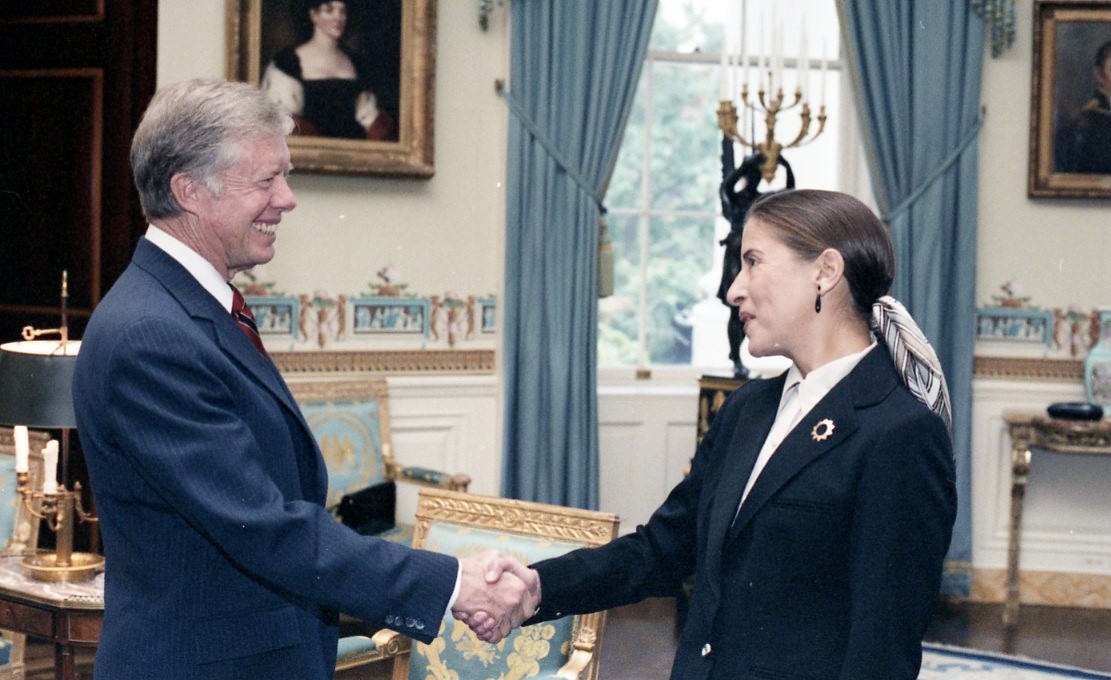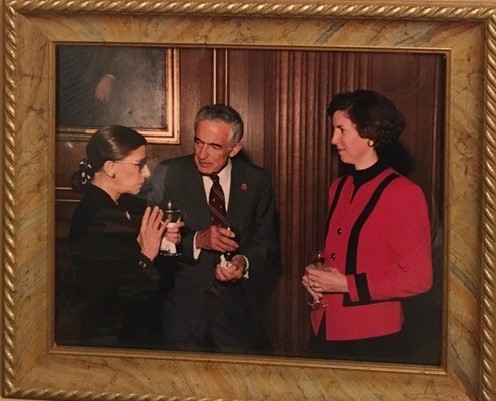RBG: Jimmy Carter’s “Notorious” Judicial Legacy
 Ruth Bader Ginsburg might not have ascended to the Supreme Court if President Carter had not developed a deliberate affirmative action strategy. Barbara Perry explains the significance of Carter’s appointment of Ginsburg to the DC Circuit bench. Perry (@BarbaraPerryUVA) is the Gerald L. Baliles Professor and Director of Presidential Studies at the University of Virginia‘s Miller Center. She was a Supreme Court Fellow at the U.S. Supreme Court in 1994-95, where she received the Tom C. Clark Award as Outstanding Fellow.
Ruth Bader Ginsburg might not have ascended to the Supreme Court if President Carter had not developed a deliberate affirmative action strategy. Barbara Perry explains the significance of Carter’s appointment of Ginsburg to the DC Circuit bench. Perry (@BarbaraPerryUVA) is the Gerald L. Baliles Professor and Director of Presidential Studies at the University of Virginia‘s Miller Center. She was a Supreme Court Fellow at the U.S. Supreme Court in 1994-95, where she received the Tom C. Clark Award as Outstanding Fellow.
James Earl Carter will go down in history as one of four unlucky presidents (out of forty-four) who did not appoint a member of the U.S. Supreme Court. Two chief executives (William Henry Harrison and Zachary Taylor) died early in their terms, and Andrew Johnson faced impeachment and a recalcitrant Congress that blocked his nominations. Carter remains the only one-term president to serve without a vacancy occurring on the nation’s highest tribunal. Yet, indirectly, he is responsible for one of the Supreme Court’s most consequential members: Ruth Bader Ginsburg.
Carter’s commitment to egalitarianism on matters of race and gender manifested itself in his approach to federal court nominations. He developed an affirmative action plan for the trial courts and the U.S. courts of appeals, the middle tier of the national judiciary. Long a bastion of white males, the ninety-four district courts and thirteen appellate courts form the core of the federal judicial structure. Distributed among a dozen geographic state clusters and the District of Columbia, plus one catch-all circuit, the courts of appeals hear the vast majority of cases from the federal trial courts. All litigants have the right to appeal a loss from the district courts, and, because the Supreme Court’s docket is completely discretionary and contains fewer than 100 cases a term, the courts of appeals are the last stop for all but a few litigants. Thus, Carter’s 262 nominations to the federal benches, a record number at the time, guided by an effort to balance the representative characteristics of appointees, especially in terms of race, ethnicity, and gender, gave him an influential role in shaping the national judiciary.
But his most lasting impact resulted from his 1980 decision to name Ruth Bader Ginsburg to the U.S. Court of Appeals for the Washington, D.C. Circuit, a proving ground for Supreme Court justices. A stellar graduate of Cornell University and Columbia Law School (after two years at Harvard Law), Ginsburg had served as the director of the ACLU’s Women’s Rights Project, during which she argued a half-dozen gender-equity cases at the U.S. Supreme Court and won all but one between 1971 and 1978.

RBG didn’t focus solely on women’s rights, however. Instead, she advocated for the law’s equal treatment of men and women. She successfully argued that the armed forces should pay civilian husbands of military personnel living allowances (as it did wives) and that widowers should receive Social Security benefits to care for their children, as a widowed mother would. This star litigator record, combined with her scholarship as a tenured Columbia Law School professor, caught Carter’s attention.
Likewise, her compelling life story captured President Bill Clinton’s imagination in 1993 when Justice Byron White retired from the nation’s highest tribunal. As Clinton’s White House counsel, Bernard Nussbaum, told the Miller Center’s Presidential Oral History team, “She had an activist background, but moderate as a judge. She’d been a judge for twenty [thirteen] years, and she was not known as a flaming liberal or a dark conservative, but very balanced. And she was the right age …. We weren’t these ideologues looking to appoint forty-year-olds that will stay forever. We were looking for people who had lived, balanced people who had a life and a wide range of experience. So she fit those criteria, and it looked like it would be an attractive appointment.” (https://millercenter.org/she-started-crying-phone)
In announcing her nomination, Clinton declared that Ginsburg was “to the women’s movement what Thurgood Marshall was to the movement for the rights of African Americans.” Her elegant and eloquent tribute to her mother moved the president to tears. Confirmed by a 96-3 Senate vote, one of the last uncontentious Supreme Court appointments before severe partisan polarization metastasized, Ginsburg was sworn in by Chief Justice William Rehnquist, on August 10, 1993, with her beloved husband Marty, a renowned tax attorney, beaming at her side.
Joining Sandra Day O’Connor as only the second women to become a member of “the priestly tribe,” the diminutive justice played an outsized role in her nearly three decades on the Court, especially in continuing her crusade for gender equity. She penned the Court’s 1996 opinion for a 7-1 majority in the decision requiring Virginia Military Institute to admit women. Justice Clarence Thomas recused himself because his son attended VMI. Only her good friend from their days on the circuit bench, and fellow opera aficionado, Justice Antonin (Nino) Scalia, dissented. Despite their polar-opposite ideologies and personas, they remained soulmates until his passing in 2016. RBG, an incorrigible introvert, adored Nino’s extroversion and his jovial humor. Imagine that! Two diametrically opposed Supreme Court justices could go hammer and tongs at each other in oral arguments and written opinions and then gather for dinner or a trip to the Kennedy Center opera house with Marty and Nino’s wife Maureen.

Even in dissent, Ginsburg reshaped the law. In the 2007 Lilly Ledbetter case, a conservative majority, led by Justice Samuel Alito, dismissed a pay inequity claim by the complainant against Goodyear Tire and Rubber Company because Ledbetter had missed a filing deadline required by the 1964 Civil Rights Act. In a stinging dissent, read from the bench, Justice Ginsburg encouraged Congress to amend the act’s restrictions on when the victims of wage discriminations could challenge their employers in federal court. Her rationale was sound: employees may not know of salary discrepancies for years. They might be slight initially but have a deleterious cumulative effect over time, as in Ledbetter’s case where her retirement pay was far less than her male counterparts. Led by New York’s Senator Hillary Clinton, Congress followed Ginsburg’s recommendation, and the Lilly Ledbetter Fair Pay Act became the first legislation signed into law by President Barack Obama after his 2009 inauguration.
In addition, Ginsburg provided votes and authored opinions upholding reproductive rights, allowing universities to maintain affirmative action policies in college and law school admissions, supporting the Jeffersonian creed of religion-government separation, advocating marriage equality, bolstering sexual privacy, and admonishing the majority in Bush v. Gore.
Although demure in social settings, Ginsburg responded enthusiastically to her many fans on the left who bestowed on her the endearing label, “Notorious RBG.” Yet her best friend, Nino Scalia, was from the opposite side of the jurisprudential spectrum. “This place specializes in reason. We reason together,” Ginsburg observed about how she and her colleagues arrive at decisions in some of the most contentious cases in American politics.
The Heritage Foundation, a conservative interest group, gleefully looked forward to replacing this liberal icon early in the Trump presidency, hoping that she could not overturn cancer’s death sentence. Yet she continued to fulfill the egalitarian agenda of Jimmy Carter’s post-Watergate presidency for nearly four additional years on the Supreme Court, succumbing to her illness just forty-six days before Trump faced the electorate. She might never have made history on the nation’s highest court, however, without the 39th president’s nomination of her to the country’s second most powerful tribunal forty years earlier.
- Having a Drink With Your Donkey: The Absurd in Antiquity
- What Happens to UVA’s Recycling? A Behind the Scenes Look at Recycling, Composting, and Reuse on Grounds
- Finding Your Center: Using Values Clarification to Navigate Stress
- UVA Club of Atlanta: Virtual Pilates Class
- UVA Club of Fairfield/Westchester: Cavs Care - Food Pantry Donation Drive
- UVA Club of the Triangle: Hoo-liday Party